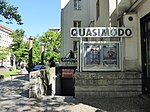Weizenbaum Institute

The Weizenbaum Institute is a research institute for interdisciplinary digitalization research. It is a joint project of research institutions from Berlin and Brandenburg, funded by the Federal Ministry of Education and Research. The partners are Free University of Berlin, Humboldt University of Berlin, Technische Universität Berlin, Berlin University of the Arts, University of Potsdam, Fraunhofer Institute for Open Communication Systems and WZB Berlin Social Science Center. The Weizenbaum Institute was awarded the tender by the German Federal Ministry of Education and Research to host the German Internet Institute, hence it is also known by this name. Founded in 2017, the institute is located in Berlin. The institute is named after Joseph Weizenbaum.
Excerpt from the Wikipedia article Weizenbaum Institute (License: CC BY-SA 3.0, Authors, Images).Weizenbaum Institute
Hardenbergstraße, Berlin Charlottenburg
Geographical coordinates (GPS) Address Nearby Places Show on map
Geographical coordinates (GPS)
| Latitude | Longitude |
|---|---|
| N 52.5082 ° | E 13.3293 ° |
Address
Hardenbergstraße
10623 Berlin, Charlottenburg
Germany
Open on Google Maps









